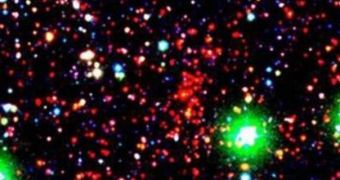After using two ground-based observatories and a space telescope as primary instruments, a wide and long-term astronomical effort, designed to discover the most distant galaxy clusters in the early Universe, has finally come to an end. Scientists at the University of California in Riverside (UCR) looked only after clusters that existed when the Universe was six billion years old or younger, but took a preference in those that were formed as soon after the Big Bang as possible.
For the investigation, the team of astronomers used optical observations from the CTIO 4 meter and CFHT 3.6 meter telescopes, as well as data collected via NASA's Spitzer Space Telescope, especially in the infrared wavelengths. Named Spitzer Adaptation of the Red-sequence Cluster Survey, or SpARCS, the initiative proved extremely successful, and the team even identified and photographed a galaxy cluster that existed early in the Universe, at about 4.8 billion years after it was created.
And, considering that between the Big Bang and the end of the Reionization Epoch (some one billion years after the Cosmos formed) there was literally a handful of stars and galaxies, the find is even more important.
“It is very exciting to have discovered such a large sample of these rare objects. We are looking at massive structures very early in the universe's history. Although we are catching these clusters at early times, we can tell by their red colors that many of the galaxies we are seeing are already quite old. We will be following up this new sample for years to come, to better understand how clusters and their galaxies form and evolve in the early universe,” the SpARCS Project Leader, UCR Associate Professor of Physics and Astronomy Gillian Wilson, explains.
Wilson and Yale University expert Adam Muzzin have also been the authors of two new studies detailing the finds and the overall results of SpARCS, in the June 20 issue of The Astrophysical Journal. The National Science Foundation (NSF)-funded Association of Universities for Research in Astronomy also took an active part in the investigation, by supplying the Cerro Tololo Inter-American Observatory (CTIO) to the research team. According to the end-result, the team behind the project discovered approximately 200 new galaxy clusters, which will keep astronomers busy studying them for a long time to come.

 14 DAY TRIAL //
14 DAY TRIAL //